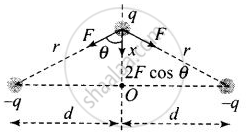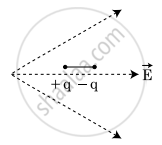Advertisements
Advertisements
प्रश्न
Two charges –q each are fixed separated by distance 2d. A third charge q of mass m placed at the mid-point is displaced slightly by x(x << d) perpendicular to the line joining the two fixed charged as shown in figure. Show that q will perform simple harmonic oscillation of time period.
`T = [(8pi^3 ε_0 md^3)/q^2]^(1/2)`

उत्तर

Let the charge q is displaced slightly by x(x << d) perpendicular to the line joining the two fixed charges. Net force on the charge q will be towards O. The motion of charge q to be simple harmonic, if the force on charge q must be proportional to its distance from the centre O and is directed towards O.
Net force on the charge Fnet = 2F cos θ
Here F = `1/(4piε_0) (q(q))/r^2 = 1/(4piε_0) q^2/((d^2 + x^2))`
And cos θ = `x/sqrt(x^2 + d^2)`
Hence, Fnet = `2[1/(4piε_0) q^2/((d^2 + x^2))][x/sqrt(x^2 + d^2)]`
= `1/(2piε_0) (q^2x)/(d^2 + x^2)^(3/2)`
= `1/(2piε_0) (q^2x)/(d^3 (1 + x^2/d^2)^(3/2)`
As x << d, then Fnet = `1/(2piε_0) (q^2x)/d^3` or Fnet = Kx
i.e., force on charge q is proportional to its displacement from the centre O and it is directed towards O. Hence, motion of charge q would be simple harmonic, where ω = `sqrt(K/m)`
And T = `(2pi)/ω = 2pi sqrt(m/K)`
⇒ T = `2pi sqrt((m * 4piε_0 d^3)/(2q^2)) = [(8pi^3ε_0 md^3)/q^2]^(1/2)`
APPEARS IN
संबंधित प्रश्न
A system has two charges qA = 2.5 × 10−7 C and qB = −2.5 × 10−7 C located at points A: (0, 0, − 15 cm) and B: (0, 0, + 15 cm), respectively. What are the total charge and electric dipole moment of the system?
In which orientation, a dipole placed in a uniform electric field is in (i) stable, (ii) unstable equilibrium?
Two charges + 3.2 x 10-19 C and --3.2 x 10-19 C placed at 2.4 Å apart to form an electric dipole. lt is placed in a uniform electric field of intensity 4 x 105 volt/m. The electric dipole moment is ______.
Polar molecules are the molecules ______.
A dipole is placed in an electric field as shown. In which direction will it move?

What work must be done to rotate an electric dipole through an angle θ with the electric field, if an electric dipole of moment p is placed in a uniform electric field E with p parallel to E?
